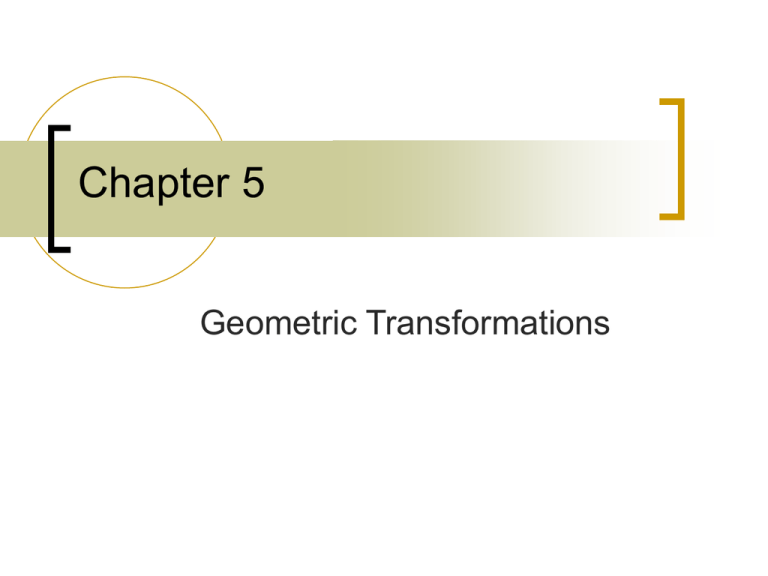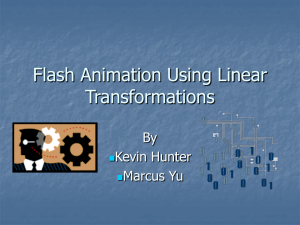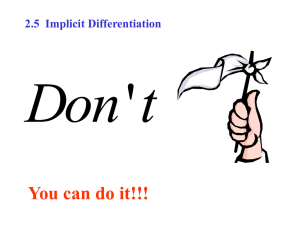Document
advertisement

Chapter 5
Geometric Transformations
Topics
5.1 Basic Two-Dimensional Geometric Transformations
5.2 Matrix Representations and Homogeneous Coordinates
5.3 Inverse Transformations
5.4 Two-Dimensional Composite Transformations
5.5 Other Two-Dimensional Transformations
5.6 Raster Methods for Geometric Transformations
5.7 OpenGL Raster Transformations
5.8 Transformations between Two-Dimensional Coordinate Systems
5.9 Geometric Transformations in Three-Dimensional Space
5.10 Three-Dimensional Translation
5.11 Three-Dimensional Rotation
5.12 Three-Dimensional Scaling
5.13 Composite Three-Dimensional Transformations
5.14 Other Three-Dimensional Transformations
5.15 Transformations between Three-Dimensional Coordinate Systems
5.16 Affine Transformations
5.17 OpenGL Geometric-Transformation Functions
5.18 Summary
5.1 Basic Two-Dimensional
Geometric Transformations
Operations that are applied to the geometric
description of an object to change its
position, orientation, or size are called
geometric transformations.
Geometric transformations can be used to
describe how objects might move around in
a scene during an animation sequence or
simply to view them from another angle.
geometric transformations
Translation
Rotation
Scaling
Reflection
shearing
Two-Dimensional Translation
We perform a translation on a single coordinate
point by adding offsets to its coordinates so as to
generate a new coordinate position.
To translate a two-dimensional position, we add
translation distances, tx and ty to the original
coordinates (x,y) to obtain the new coordinate
position (x’,y’),
x x tx
'
y y ty
'
The two-dimensional translation equations in the
matrix form
จากรู ป
x x tx
ให้
y
y y ty
x
P
y
'
'
'
'
'
P (x , y )
T
P ( x, y )
t x
T
t y
และ
ty
tx
x
จะได้
'
x
'
P
'
y
x ' x t x
'
y y t y
P P T
'
Two-Dimensional Rotation
We generate a rotation transformation of an
object by specifying a rotation axis and a
rotation angle.
A two-dimensional rotation of an object is
obtained by repositioning the object along a
circular path in the xy plane.
Parameters for the two-dimensional rotation
are
The rotation angle θ
A position (x,y) – rotation point (pivot
point)
The two-dimensional rotation
x r cos( ) r cos cos r sin sin
'
y r sin( ) r cos sin r sin cos
'
y
Polar coordinate system
x r cos
'
'
'
y r sin
O (x , y )
O ( x, y )
P ( 0 ,0 )
x
x x cos y sin
'
y x sin y cos
'
The two-dimensional rotation
x ' cos - sin x
'
sin
cos
y
y
y
'
'
'
O R O
'
O (x , y )
O ( x, y )
โดยที่
x
P ( 0 ,0 )
และ
cos - sin
R
sin cos
x
O
y
Rotation
'
x
'
O
'
y
matrix
Ex. 1
1.0
0.5
Rotation of a point about an arbitrary pivot position
x ( x x r ) cos ( y y r ) sin x r
'
y ( x x r ) sin ( y y r ) cos y r
'
y
'
'
'
O (x , y )
x ' cos - sin x x r x r
'
cos y y r y r
y sin
O ( x, y )
O R O P
'
*
P ( xr , yr )
x
โดยที่
'
x
x
*
O
'
y y
Two-Dimensional Scaling
To alter the size of an
object, we apply a
scaling transformation.
A simple twodimensional scaling
operation is performed
by multiplying object
positions (x,y) by
scaling factors sx and
sy to produce the
transformed
coordinates (x’,y’).
x x sx
'
y y sy
'
x' sx 0 x
'
y 0 s y y
P SP
'
Any positive values can be assigned to the
scaling factors.
Values less than 1 reduce the size of
object;
Values greater than 1 produce
enlargements.
Uniform scaling – scaling values have the
same value
Differential scaling – unequal of the
scaling factor
Scaling relative to a chosen fixed point
x x s x x f (1 s x )
'
y y s y y f (1 s y )
'
y
P1
Pf ( x f , y f )
x ' s x 0 x 1 s x 0 x f
'
0
s
0
1
-s
y
y
y
y
yf
P2
P S P S Pf
'
P3
x
*
5.2 Matrix Representations and
Homogeneous Coordinates
Many graphics applications involve
sequences of geometric transformations.
Hence we consider how the matrix
representations can be reformulated so that
such transformation sequence can be
efficiently processed.
Each of three basic two-dimensional
transformations (translation, rotation and
scaling) can be expressed in the general
matrix form
P and P ’ = column vectors,
coordinate position
'
P
M1 = 2 by 2 array containing
multiplicative factors, for
translation M1 is the identity
matrix
M2 = two-element column matrix
containing translational terms, for
rotation or scaling M2 contains
the translational terms associated
with the pivot point or scaling
fixed point
M1 P M 2
P M1 P M 2
'
x ' 1
'
y 0
0 x t x
t
1 y y
Translation
x ' cos - sin x x r x r
'
y sin cos y y r y r
Rotation
x ' cos - sin x cos - sin x r x r
'
y sin cos y sin cos y r y r
x ' s x 0 x 1 s x 0 x f
'
0
s
0
1
-s
y y
y
y
yf
Scaling
To produce a sequence of transformations
such as scaling followed by rotation then
translation, we could calculate the
transformed coordinates one step at a time.
A more efficient approach is to combine the
transformations so that the final coordinate
positions are obtained directly from the
initial coordinates, without calculating
intermediate coordinate values.
Homogeneous Coordinates
Multiplicative and translational terms for a
two-dimensional geometric transformations
can be combined into a single matrix if we
expand the representations to 3 by 3
matrices.
Then we can use the third column of a
transformation matrix for the translation
terms, and all transformation equations can
be expressed as matrix multiplications.
But to do so, we also need to expand the
matrix representation for a two-dimensional
coordinate position to a three-element column
matrix.
A standard technique for accomplishing this is
to expand each two-dimensional coordinateposition representation (x,y) to a threeelement representation (xh,yh,h), called
homogeneous coordinates, where the
homogeneous parameter h is a nonzero
value such that
xh
yh
x
,
y
h
h
A convenient choice is simply to set h=1.
Each two-dimensional position is then
represented with homogeneous coordinate
(x,y,1).
The term “homogeneous coordinates” is
used in mathematics to refer to the effect of
this representation on Cartesian equations.
x'
1
'
y
0
1
0
0
1
0
tx x
ty y
1 1
Translation
P T (t x , t y ) P
'
Rotation
x sx 0 0 x
'
y 0 s y 0 y
1
1
0
0
1
P R ( ) P
'
'
P S (sx , s y ) P
'
x ' cos - sin
'
y sin cos
1 0
0
Scaling
0x
0 y
1 1
5.3 Inverse Transformations
T
1
1
0
0
0 - tx
1 - ty
0 1
Inverse translation matrix
Inverse rotation matrix
R
1
cos sin
sin cos
0
0
0
0
1
S
Inverse scaling matrix
1
1
s 0 0
x
1
0
0
sy
0 0 1
5.4 Two-Dimensional Composite
Transformations
Using matrix representations, we
can set up a sequence of
transformations as a composite
transformation matrix by
calculating the product of the
individual transformations.
Thus, if we ant to apply two
transformations to point position
P, the transformed location would
be calculated as
P M 2 M1P
'
P M P
'
(1,3)
(2,3)
(3,2)
(-2,1)
(1,1)
(-1,1)
(2,1)
(a)
(b)
(-2,-1)
(-1,-1)
(1.63,2.37)
(0.77,1.87)
(-1.37,0.37)
(2.63,0.63)
(-2.23,-0.13)
(1.77,0.13)
(c)
(-0.37,-1.37)
(-1.23,-1.87)
(d)
Composite Two-dimensional Translations
P T ( t 2 x , t 2 y ) {T ( t1 x , t1 y ) P }
'
P {T ( t 2 x , t 2 y ) T ( t1 x , t1 y )} P
'
composite
transform
ation matrix
1 0 t 2 x 1 0 t1 x 1 0 t1 x t 2 x
0 1 t 2 y 0 1 t1 y 0 1 t1 y t 2 y
0 0 1 0 0 1 0 0
1
T ( t 2 x , t 2 y ) T ( t1 x , t1 y ) T ( t1 x t 2 x , t1 y t 2 y )
Composite Two-dimensional Rotations
P R ( 2 ) { R ( 1 ) P }
'
P { R ( 2 ) R ( 1 )} P
'
composite
transform ation matrix
R ( 2 ) R ( 1 ) R ( 1 2 )
Composite Two-dimensional Scaling
composite
transform ation matrix
S2x 0
0 S1x 0 0 S1x S 2 x
0
0
S 2 y 0 0
S1 y 0
0
S1 y S 2 y 0
0
0
0
0
1
0
1
0
0
1
S ( s 2 x , s 2 y ) S ( s1 x , s1 y ) S ( s1 x s 2 x , s1 y s 2 y )
General Two-dimensional PivotPoint Rotation
A transformation sequence for rotating
an object about a sepcified pivot point
using the rotation matrix R(θ).
Translate the object so that the pivot-point
position is moved to the coordinate origin.
Rotate the object about the coordinate
origin.
Translate the object so that the pivot point
is returned to its original position.
(xr,yr)
(a)
(xr,yr)
(b)
(xr,yr)
(c)
(xr,yr)
(d)
1
0
0
0
1
0
x r cos - sin
y r sin cos
0
1 0
cos - sin
sin cos
0
0
0 1
0 0
1 0
0 - xr
1 - yr
0 1
x r ( 1- cos θ) y r sin θ
y r ( 1- cos θ) x r sin θ
1
T ( x r , y r ) R ( ) T ( x r , y r ) R ( x r , y r , )
General Two-dimensional FixedPoint Scaling
A transformation sequence to produce a twodimensional scaling with respect to a selected
fixed position (xf,yf).
Translate the object so that the fixed point
coincides with the coordinate origin.
Scale the object with respect to the coordinate
origin.
Use the inverse of the translation in step (1) to
return the object to its original position.
(xf,yf)
(a)
(xf,yf)
(b)
(xf,yf)
(c)
(xf,yf)
(d)
1 0
0 1
0 0
x f s x 0 0 1 0 - x f
y f 0 s y 0 0 1 - y f
1 0 0 1 0 0 1
s x 0 x f ( 1-s x )
1 s y y f ( 1-s y )
0 0
1
T ( x f , y f ) S ( s x , s y ) T ( x f , y f ) S ( x f , y f , ( s x , s y ))
General Two-dimensional Scaling
Directions
We can scale an object in
other directions by rotating
the object to align the
desired scaling directions
with the coordinate axes
before applying the scaling
transformation.
Suppose we want to apply
scaling factors with values
specified by parameters s1
and s2 in the directions
shown in fig.
y
s2
x
s1
The composite matrix resulting from the product of
- rotation so that the directions for s1 and s2
coincide with the x and y axes
- scaling transformation S(s1,s2)
- opposite rotation to return points to their
original orientations
s1Cos 2 s 2 Sin 2
-1
R ( ) S ( s1 , s 2 ) R ( ) ( s 2 s1 ) Cos Sin
0
( s 2 s1 ) Cos Sin
s1 Sin s 2 Cos
2
2
0
0
0
1
y
y
(2,2)
(1/2,3/2)
(0,1)
(1,1)
(3/2,1/2)
(0,0)
(1,0)
s1= 1
x
s2=2
(0,0)
x
Matrix Concatenation Properties
Transformation products may not be
commutative.
The matrix product M2M1 is not equal to M1M2.
This means that if we want to translate and
rotate an object, we must be careful about the
order in which the composite matrix is
evaluated.
Reversing the order in which a sequence of
transformations is performed may affect the
transformed position of an object.
2 Rotation
1 Translation
1 Rotation
2 Translation
General Two-dimensional Composite
Transformations and Computational
Efficiency
x ' rs xx
'
y rs yx
1
0
rs xy trs x x
rs yy trs y y
0
1 1
rs** are the multiplicative rotation-scaling terms
(rotation angles, scaling factors)
trsx and trsy are the translation terms
(translation distances, pivot-point and fixedpoint coordinates, rotation angles, scaling
parameters)
Example
Scale and
rotate about its centroid coordinates (xc,yc)
and
translate
T (t x , t y ) R ( x c , y c , ) S ( x c , y c , s x , s y )
s x cos
s x sin
0
- s y sin
s y cos
0
x c (1 s x cos ) y c s y sin t x
y c (1 s y cos ) x c s x sin t y
1
Two-dimensional Rigid-body Transformation
If a transformation matrix includes only
translation and rotation parameters, it is a
rigid-body transformation matrix.
rxx
r yx
0
rxy tr x
r yy tr y
0 1
r** are the multiplicative rotation terms (rotation angles)
trx and try are the translation terms (translation
distances, pivot-point and fixed-point coordinates,
rotation angles)
5.5 Other Two-Dimensional
Transformations
Reflection
For a two-dimensional reflection, the
image is generated relative to an axis
of reflection by rotating the object 180º
about the reflection axis.
Reflection about the line y=0 (the x
axis)
1 0 0
0 -1 0
0 0 1
Reflection about the line x=0 (the y
axis)
1
0
0
0
1
0
0
0
1
Reflection about any reflection point in
the xy plane
Reflection point
1
0
0
0
-1 0
0 1
0
Reflection about the reflection axis y=x
0
1
0
0
0 0
0 1
1
1.
Rotate the line y=x with respect to
the original through a 45 angle
2.
Reflection with respect to the x axis
3.
Rotate the line y=x black to its
original position with a
counterclockwise rotation through
45
Reflection about the reflection axis y=-x
0 -1 0
-1 0 0
0 0 1
1.
Clockwise rotate the line y=-x with
respect to the original through a 45
angle
2.
Reflection with respect to the y axis
3.
Rotate the line y=-x black to its
original position with a
counterclockwise rotation through
45
y = -x
Shear
A transformation that distorts the
shape of an object such that the
transformed shape appears as if the
object were composed of internal
layers that had been caused to slide
over each other is called a shear.
An x-direction shear
1
0
0
sh x 0
1 0
0 1
transforma tion matrix
y
(0,1)
y
(2,1)
(1,1)
shx = 2
(0,0)
(1,0)
(0,0)
(1,0)
(3,1)
We can generate x-direction shears
relative to other reference lines
sh x -sh x y ref
1
0
0
1
1
0
0
y
(0,1)
transforma tion matrix
y
(1,1)
(1,1)
(2,1)
shx = ½
yref = -1
(0,0)
(1,0)
yref = -1
(0,0)
(1/2,0)
yref = -1
(3/2,0)
A y-direction shears relative to the line
x=xref is generated with
1
sh y
0
0
0
1 -sh y x ref
0
1
y
transforma tion matrix
y
(1,2)
(0,3/2)
(0,1)
(1,1)
(1,1)
shy = ½
xref = -1
xref = -1 (0,0)
(1,0)
(0,1/2)
xref = -1 (0,0)
Shear operations can be expressed as
sequences of basic transformations.
The x-direction shear matrix
1
0
0
sh x 0
1 0
0 1
can be represented as a composite
transformation involving a series of rotation
and scaling metrices.
5.6 Raster Methods for Geometric
Transformations
Functions that manipulate rectangular pixel
arrays are called raster operations and
moving a block of pixel values from one
position to another is termed a block
transfer, a bitblt or a pixblt.
All bit settings in the rectangular area are
copied as a block into another part of the
frame buffer.
We can erase the pattern at the original
location by assigning the background color
to all pixels within that block.
Array rotations that are not multiples of 90º
1
4
7
10
3
5 6
8 9
11 12
2
(a)
3 6
2 5
1 4
9 12
8 11
7 10
12 11 10
9 8 7
6 5
4
3
2
1
(b)
(c)
The original array is shown in (a),
the positions of the array elements after a 90º
counterclockwise rotation are shown in (b), and
the position of the array elements after a 180º
rotation are shown in (c).
5.7 OpenGL Raster Transformations
A translation of a rectangular array of pixelcolor values from one buffer area to another
can be accomplished in OpenGL as a copy
operation:
glCopyPixels(xmin, ymin, width, height, GL_COLOR);
This array of pixels is to be copied to a
rectangular area of a refresh buffer whose
lower-left corner is at the location specified
by the current raster position.
We can rotate a block of pixel-color values in 90-degree
increments by
first saving the block in an array,
glReadPixels(xmin, ymin, width, height, GL_RGB,
GL_UNSIGNED_BYTE, colorArray);
then rearranging the elements of the array and
placing it back in the refresh buffer.
glDrawPixels(width, height, GL_RGB, GL_UNSIGNED_BYTE,
colorArray);
We set the scaling facters with
glPixelZoom(sx,sy);
5.8 Transformations between TwoDimensional Coordinate Systems
y’
y
x’
θ
yn
xn
x
A Cartesian x’y’ system specified with coordinate origin
(xn,yn) and orientation angle θ in a Cartesian xy reference
frame.
To transform object descriptions from xy
coordinates to x’y’ coordinates, we set up a
transformation that superimposes the axes
onto the x’y’ axes.
This is done in two steps:
Translate so that the origin (xn,yn) of the x’y’
system is moved to the origin (0,0) of the xy
system.
Rotation the x’ axis onto the x axis.
1)Translatio n
1 0 x n
T ( x n , y n ) 0 1 y n
0 0 1
y’
y
y
y’
P
x’
y
x’
y’
θ
yn
P
θ
xn
x
x
x’
x
2 ) clockwise rotation
cos sin 0
2.1) R ( ) - sin cos 0
0
0
1
y
y’
y
y’
P
x’
y
y
P
y’
θ
x’
x
composite matrix
x
x
M xy , x ' y ' R ( ) T ( x n , y n )
x
OR
2.2) An alternate method for
describing the orientation of the
x’y’ coordinate system is to
specify a vector V that indicates
the direction for the positive y’
axis.
We can specify vector V as a
point in the xy reference frame
relative to the origin of the xy
system, which we can convert to
the unit vector,
y’
V
y
P
x’
θ
yn
xn
x
v
V
V
(v x , v y )
We obtain the unit vector u along the x’ axis by
applying a 90º clockwise rotation to vector v
u ( v y , v x ) (u x , u y )
The matrix to rotate the x’y’ system into
coincidence with the xy system can be written as
u x u y 0
R v x v y 0
0 0
1
OR
In the case that we
coordinates of P0 and P1
are known,
v
P1 - P0
P1 - P0
y’
V
y
P
x’
P1
yn
θ
P0
xn
x
(v x , v y )
(xf,yf)
(xf,yf)
(a)
(b)
(xf,yf)
(c)
(xf,yf)
(d)
(xf,yf)
(e)
(xf,yf)
(xf,yf)
(f)








